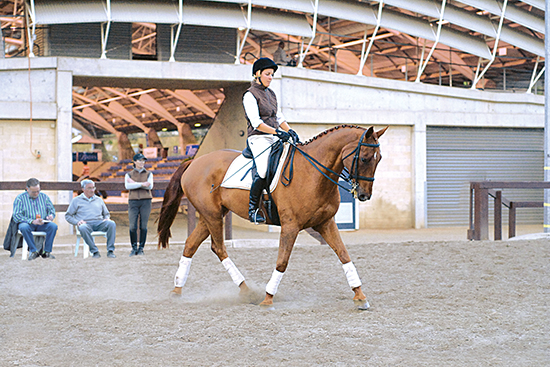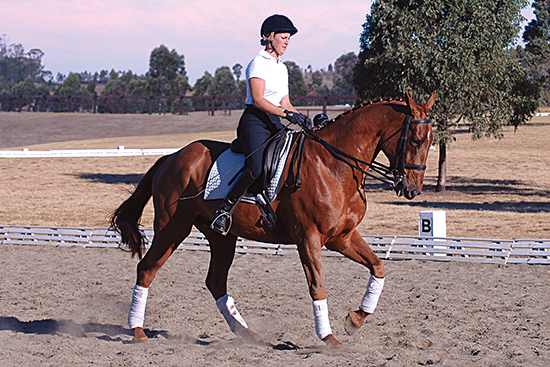 Bimbo Peilicke helps out at the Australian Dressage Championships
Bimbo Peilicke helps out at the Australian Dressage Championships
Story by Chris Hector and Photos by Roz Neave
Siegfried ‘Bimbo’ Peilicke has become a regular visitor to the Australian scene. On his last visit he almost didn’t make it, since right up until he boarded the plane he was working with Canadian dressage star, Cindy Ishoy as she prepared Proton for the Dressage World Cup Final in Amsterdam. In Australia there was no rest for Bimbo as he warmed in his regular students and caught up with his ‘lesson with’ pupil from his last visit, Belinda Bristow.
He was happy with his pupil’s progress, and Belinda was delighted to be told she had been the best student of the day, until the adjective ‘eventing’ was added…
So how does it feel, you were the most improved eventer student?
“Well considering I was the only eventer, pretty good.”
Seriously the horse did go differently?
“Yes, he went much better. It was good to see that what I was doing at home was the right thing, I wasn’t sure when I practising it at home if I was on the right track or if when I got here he would scream at me ‘what have you been doing?’ so it was nice to get the praise.”
From the outside of the ring it looked like the horse was much softer and looser in his work, especially in the walk, he was much softer through the body. Is that what you had been working on?
“Yes, just working on getting him relaxed and trying to get him to come up and carry himself instead of having to always be asking for it. He is much happier to be up there now than he was even a month ago.”
And that is still a battle, getting him to come up and not fall on his forehand?
“Definitely, especially because when we jump it is all about trying to get him low and reaching, so to go from jumping to dressage, trying to get him up again, it is so difficult. The jumping feels like it undoes all the dressage, and then I have to go back and start it all over again. We are managing to do it somehow.”
What exercises were you working on at home?
“Just trying to get him up, when he did roll over just trying to half halt and soften, and doing that over and over again until he did it instead of running off. When I first started to do it he would just shoot off then I would just hang on and it just wasn’t working, he would just freak out and get really stressed by it. Eventually he got pretty good at it.”
So have you been doing any competitions with him?
“Just eventing. I did a three day about two weeks ago, Scone, he had a week off after that and he has been back in for a week.”
So what was your dressage like at Scone?
“It was really good. I was really happy with it. Much better competition frame than we have ever had before. It was the best test we have done so far.”
Do you think you have got something to build on?
“Definitely. I have a lot to go home with and work on, everything is just about trying to get a competition frame now instead of just schooling him low all the time.”
Hallelujah, Belinda has learned that all-important lesson – to ride your horse from behind, up and out!
And Bimbo was well pleased with the progress:
“The horse was better, more even in the connection.”
So what does she have to do now?
“In all the movements now the next step is the horse needs more expression. To achieve this expression she needs to put more emphasis on her tempo changes so that the horse does working trot, collected trot, and this will bring about a more expressive trot. It’s the same in canter, same in all the movements.”
“Today Belinda went much better, she managed to adjust the horse much quicker, it didn’t take her as long to get a hold of him today.”
Looking at the riders overall at this show, are there any consistent problems reoccurring with the riders?
“The riders don’t bring the horse to the point where they have the hind legs underneath and are carrying themselves. This is the biggest problem that is seen here.”
And the hands? Compared to Germany we see much more ‘active hands’ in this country?
“No. Not necessarily. In the whole world you see people riding a lot with their hands. It is not new here.”
Looking at the horses in Australia after having visited for 10 years, is there a difference in the horses in the competitions?
“Maybe the horses don’t go to competitions so much like they do in Europe but there is not a lot of difference in the quality of the horses. There are some very nice horses, some impressive horses and riders.”
So the standard has improved in the 10 years?
“Yes, very much so. Dramatically so. The difference between the riders in Germany and here, is the competition experience. The riders over there ride far more competitions than you do here – not just at this high level, a test is a test, as a competitor this is where you have to produce the goods.”
Right from the first moment he arrived at SIEC for the CDI, Bimbo was worried about the condition and the preparation he saw with the horses.
“The feeding is also very important. On one hand it is the riding, but on the other hand it is the feeding. When you look at the horse it is a little light in the condition, but it is also a flat looking horse. If you can get the balance of the work and the feed right you produce a horse with some spark. It is not just down to the working, it is also up to the feeding as to how the horses present and how they cope with the work.”
You thought some of the Grand Prix horses were looking flat even at the trot up?
“Not just the Grand Prix horses, you could already see the sloppy back legs in the horses in the trot up. You already wonder how they are going to be under saddle!”
So is that because under saddle they haven’t woken them up enough behind?
“It is tied into the way they work, because the horses look tired in the legs, they have actually done too much work. They should look fresher at the first day of a competition, for the trot up, not so tired and like they have already done a lot of work.”
What do we in Australia need to do to take the next step?
More competitions. You need more big competitions, where the riders can be put under this sort of pressure and be able to produce what they do at these events.”
 This article first appeared in THM October 2006.
This article first appeared in THM October 2006.

